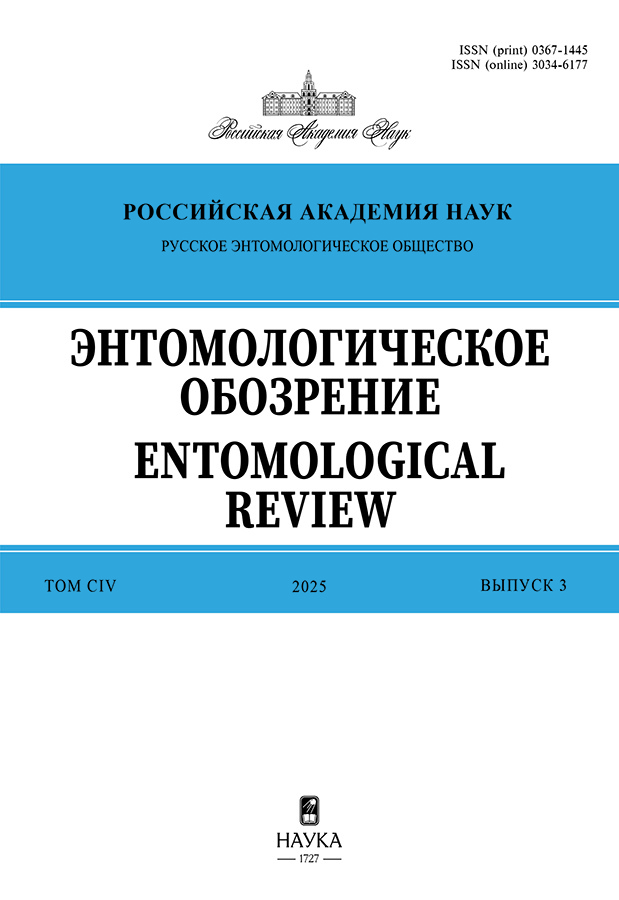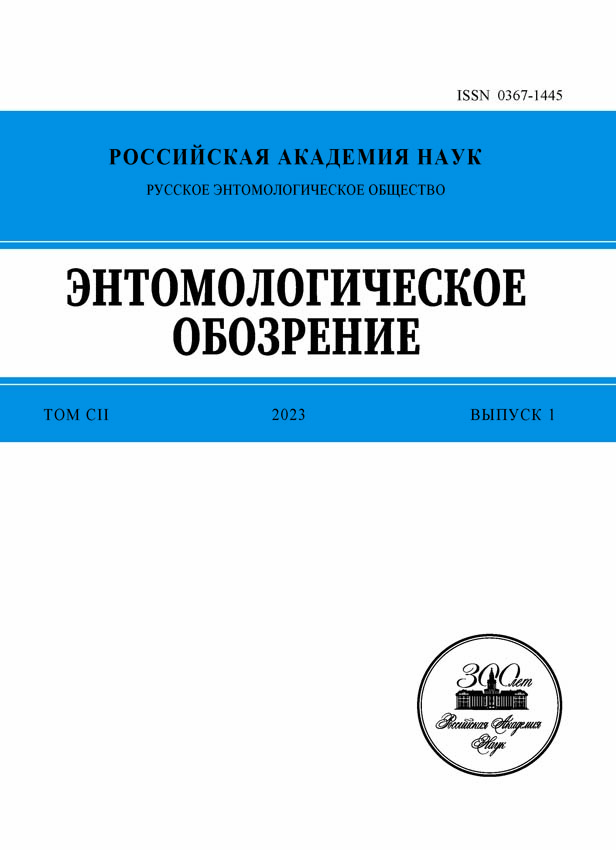Том 102, № 1 (2023)
Статьи
Влияние термопериода на индукцию диапаузы потомства Trichogramma telengai Sor. (Hymenoptera, Trichogrammatidae): коррекция, но не замена фотопериода
Аннотация
В лабораторных условиях было исследовано влияние постоянных температур (15, 20, 25 и 30 °C) и термопериодов (ежесуточного чередования периодов высокой (25 или 30 °C) и низкой (15 или 20 °C) температуры) на материнскую индукцию диапаузы потомства у самок паразитоида-яйцееда Trichogramma telengai Sor. (Hymenoptera, Trichogrammatidae). Каждое сочетание температур тестировали в двух вариантах: «короткодневном» (длительность периодов высокой и низкой температур - 12 ч) и «длиннодневном» (длительность периода высокой температуры - 18 ч, низкой - 6 ч). Кроме того, тестировали постоянные температуры, равные средним для всех термопериодов. Опыты показали, что термопериоды и постоянные температуры существенно влияют на индукцию диапаузы потомства T. telengai как во взаимодействии с различными фотопериодами, так и в условиях постоянной темноты. Однако в качестве сигнального фактора, несущего информацию о длине дня (и тем самым о времени года), термопериоды трихограммами, по-видимому, не воспринимаются.
Энтомологическое обозрение. 2023;102(1):5-12
 5-12
5-12


Репродуктивное поведение уховертки Forficula vicaria Semenov, 1902 (Dermaptera, Forfi culidae)
Аннотация
Приведены сведения о репродукции уховертки For cula vicaria Semenov (Dermaptera, For culidae) в Приморском крае. Общий период репродуктивной активности занимает от 47 до 52 дней. Первые копулирующие пары отмечены в начале 3-й декады августа, а последние - в середине октября. Время совместного нахождения в садках самца и самки до начала копуляции составляло для пары, образованной в конце июля, 28 сут; в начале августа - 17 сут; в середине августа - 5 сут, а в конце августа - менее суток. За все время наблюдений за отдельными парами отмечено 11-17 повторных копуляций. В течение суток число повторных копуляций у этого вида составляло от одного до трех, каждая продолжительностью от 30 мин до 10 ч с перерывами от 20 мин до 9 ч, причем после копуляции наблюдалось активное питание насекомых в течение 1.5-4 ч. Самки начинают откладывать яйца с конца сентября. Плодовитость составляет от 52 до 71 яйца, а число яиц, отложенное между спариваниями в течение суток, колеблется от 4 до 33. Зрелые яйца в яичниках самок присутствуют до середины октября. Для F. vicaria характерна забота о потомстве. В естественных условиях с середины сентября уховертки выкапывают норы, в которых и зимуют, охраняя яйцекладку.
Энтомологическое обозрение. 2023;102(1):13-20
 13-20
13-20


Особенности биологии Urostylis annulicornis Scott (Heteroptera, Urostylididae) на юге Дальнего Востока России
Аннотация
На юге Приморского края из перезимовавшей под корой дуба яйцекладки выведены в садках личинки и имаго Urostylis annulicornis Scott, 1874 . Личинки I возраста отрождаются до начала вегетации дуба и развиваются, не выходя из-под коры и высасывая желеобразную оболочку яйцевой массы. По мере разворачивания листьев дуба личинки I возраста покидают убежище и переходят к питанию соком листьев; жизнь имаго продолжается в кроне дуба. Описаны последовательность линек всех личиночных стадий, их питание и сроки сезонного развития вида в природе.
Энтомологическое обозрение. 2023;102(1):21-34
 21-34
21-34


Популяционные характеристики и новые находки ясеневой изумрудной узкотелой златки Argrilus planipennis Fairm. (Coleoptera, Buprestidae) в Санкт-Петербурге в 2022 г.
Аннотация
Продолжены исследования в С.-Петербурге и его окрестностях популяции ясеневой изумрудной узкотелой златки Agrilus planipennis Fairm . (ЯИУЗ) во вторичном ареале. Сохраняется опасность массового поражения насаждений ясеня, роль которого в структуре городских посадок чрезвычайно велика. Вырубка зараженных деревьев в двух очагах остановила дальнейшее размножение ЯИУЗ в этих местах. В трех других очагах размножение златки продолжается. Повторный мониторинг модельных деревьев в очаге в Невском р-не показал увеличение плотности поселения златки. Выживаемость ЯИУЗ сохранилась приблизительно на том же уровне, что и в 2020 г. Плотность заселения златкой ствола увеличивается с его высотой. Роль паразитоидов в контроле численности златки несущественна. В древесине одновременно находились особи на всех стадиях развития - личинки, куколки и имаго. По-видимому, в условиях С.-Петербурга жизненный цикл ЯИУЗ сильно зависит от теплообеспеченности и других особенностей микростаций. Признаки заселения златкой (лётные отверстия) проявляются только после вылета первых жуков. Значительная часть особей остается в древесине на личиночной и куколочной стадиях, поэтому своевременное обнаружение, уборка и уничтожение деревьев с лётными отверстиями - основной инструмент контроля распространения ЯИУЗ. Эффективным вспомогательным мероприятием была бы интродукция паразитоидов этого вредителя, которые в настоящее время в популяции златки практически отсутствуют. Необходимы постоянные наблюдения за ясенями, прежде всего в известных местах обитания вредителя в Петродворцовом и Невском районах. Для системного решения проблемы требуется активное участие всех управляющих структур, в компетенции которых находятся городские насаждения.
Энтомологическое обозрение. 2023;102(1):35-43
 35-43
35-43


Влияние экологических факторов на срок выхода имаго колорадского жука Leptinotarsa decemlineata (Say) (Coleoptera, Chrysomelidae) из почвы в Центрально-лесостепном приобском агроландшафтном районе
Аннотация
В результате многолетних исследований установлено комплексное влияние глубины промерзания почвы, высоты снежного покрова, суммы осадков, температуры воздуха и почвы на глубине 0-20 и 20-40 см, суммы эффективных температур и продолжительности светового дня на срок выхода имаго Leptinotarsa decemlineata (Say) из почвы после зимовки в посадках картофеля в Центрально-лесостепном Приобском агроландшафтном районе. Значения этих экологических факторов за период с сентября предыдущего года по июнь текущего года на 27.2 % определяли дату выхода перезимовавших имаго. Доля влияния условий предшествующего года составляла 50.5, а условий текущего года - 31.1 %. Установлено, что выход перезимовавших имаго затягивается при уходе их на зимовку во влажную и прохладную почву. В ноябре на дату выхода начинают влиять высота снежного покрова и глубина промерзания почвы (доли влияния 86.8 и 79.5 %), доля влияния которых в совокупности с перечисленными ранее факторами составляет 35.3 %. В декабре прослеживалась такая же тенденция. В январе до 84.3 % увеличилась значимость температуры почвы, а значимость всего комплекса факторов проявилась в 26.7 % случаев. В феврале наблюдался этот же тренд, а доля влияния всех ранее перечисленных факторов увеличилась до 43.0 %. С марта отмечено снижение воздействия глубины промерзания почвы и высоты снежного покрова до 42.3 %, а с апреля начинали оказывать влияние сумма осадков и температура воздуха (в 81.8 и 65.8 % случаев соответственно). В мае на дату выхода жуков оказывала влияние температура почвы на глубине 0-20 и 20-40 см - соответственно 80.7 и 94.0 % - и продолжительность светового дня - 91.1 %. В июне основными факторами стали сумма осадков, температура почвы и продолжительность светового дня - 100 %, при этом воздействие накопленной СЭТ составило 50.0 %. Таким образом, в этом регионе в среднем начало выхода имаго из почвы начиналось 17 июня ± 12 дней при достижении среднесуточной температуры воздуха +19.1 ± 5.8 °C, сумме осадков (при температуре воздуха > 10 °C) 70.7 ± 39.1 мм и прогреве почвы на глубине 0-20 см и 20-40 см до +17.6 ± 3.8 °C и +14.8 ± 2.5 °C соответственно. СЭТ в этот период составляла 149.0 ± 64.1 гр.-дн.
Энтомологическое обозрение. 2023;102(1):44-62
 44-62
44-62


Сезонные изменения численности личинок кровососущих комаров (Diptera, Culicidae) в Березинском биосферном заповеднике (Республика Беларусь) .
Аннотация
Изучены сроки развития и сезонные изменения численности личинок 19 видов комаров из родов Aedes , Anopheles и Culex (Diptera, Culicidae) в период с апреля по сентябрь 2016-2018 гг. на территории Березинского биосферного заповедника (Беларусь, Витебская область).
Энтомологическое обозрение. 2023;102(1):63-78
 63-78
63-78


Cтруктура и распределение сенсилл на щупиках ротового аппарата имаго ручейников сем.Hydropsychidae (Trichoptera)
Аннотация
Методами сканирующей электронной микроскопии выполнено сравнительно-морфологическое исследование структуры и распределения сенсилл на максиллярных и лабиальных щупиках у 17 видов из 12 родов сем. Hydropsychidae. На щупиках исследованных видов обнаружены сенсиллы 4 типов: длинные трихоидные, хетоидные, кампаниформные и лепестковидные сенсиллы; базиконические и псевдоплакоидные сенсиллы на щупиках не найдены. У всех исследованных видов отсутствуют апикальные сенсорные комплексы на вершинах обеих пар щупиков, где имеются только длинные хетоидные сенсиллы. У представителей 4 подсемейств (Arctopsychinae, Diplectroninae, Hydropsychinae, Macronematinae) обнаружены лепестковидные сенсиллы, которые образуют сенсорные поля на 4-м (Arctopsychinae) или 3-м и 4-м члениках максиллярных щупиков и всегда отсутствуют на лабиальных. В состав сенсорных полей входит от 5-10 сенсилл у Hydropsychinae до 40 - у Arctopsychinae.
Энтомологическое обозрение. 2023;102(1):79-90
 79-90
79-90


Новый род, новые подроды и новые виды палеарктической фауны свинушек (Homoptera, Delphacidae) трибы Delphacini
Аннотация
Описан новый род Lepto oria gen. n. с типовым видом Delphax leptosoma Flor, 1861, ранее относимым к роду Florodelphax Vilbaste, 1968 с типовым видом Delphax paryphasma Flor, 1861. Delphax paryphasma возвращен в род Struebingianella W. Wagner, 1963, к которому в связи с этим род Florodelphax сведен в синонимы и установлена новая синонимия: Struebingianella W. Wagner, 1963 (= Florodelphax Vilbaste, 1968, syn. n.). В роде Unkanodes Fennah, 1956 описаны два новых подрода: Parapate subgen. n., типовой вид Calligypona latespinosa Dlabola, и Pliapate subgen. n., типовой вид Elymodelphax tanasijevici Dlabola. Описаны новые виды Thymalops erianthi sp. n. из Средней Азии и Eurysa lugubris sp. n. из Средней Азии и с Кавказа.
Энтомологическое обозрение. 2023;102(1):91-99
 91-99
91-99


К систематике жуков-листоедов рода Colaspoides Laporte, 1833 (Coleoptera, Chrysomelidae: Eumolpinae) с полуострова Малакка и с Больших Зондских островов
Аннотация
Описаны 13 новых видов жуков-листоедов рода Colaspoides Laporte - С. cameronensis sp. n., С. asarovi sp. n., С. nikandrovitshi sp. n., С. pahangensis sp. n. с полуострова Малакка и Colaspoides aeneoviridis sp. n., C. borneomontana sp. n., C. bruneiensis sp. n., C. metallactus sp. n., C. costipennis sp. n., C. gunungensis sp. n., C. latipalpis sp. n., C. paraviolacea sp. n. и C. vityukovae sp. n. с о. Борнео. Составлены новые определительные таблицы для видовых комплексов Colaspoides cognata Baly, 1867, C. borneomontana sp. n. и C. viridimarginata Baly, 1867.
Энтомологическое обозрение. 2023;102(1):100-155
 100-155
100-155


Новые виды комаров-толстоножек, близких к Bibio marci (Linnaeus, 1758) (Diptera, Bibionidae)
Аннотация
По материалам из России, Турции, Северной Африки (Марокко), с Канарских островов и из Киргизии исследован комплекс видов, близких Bibio marci (Linnaeus, 1758) и характеризующихся черным у обоих полов телом. Описаны 4 новых вида ( B. alborzensis sp. n., B. admirabilis sp. n., B. maroccanus sp. n. и B. pravdini sp. n.), различающихся по окраске и жилкованию крыла, строению головы самки (строению и опушению лба) и гениталий самцов (тергита 9, церок, гипо прокта и эдеагуса). Составлена определительная таблица видов по самцам и самкам.
Энтомологическое обозрение. 2023;102(1):156-176
 156-176
156-176


XVI съезд Русского энтомологического общества.
Аннотация
XVI съезд Русского энтомологического общества с сателлитным мероприятием - XII Чтениями памяти О. А. Катаева - проходил в Москве с 22 по 26 августа 2022 г. на базе Московского государственного университета им. М. В. Ломоносова. Информационное сопровождение съезда было организовано на сайтах кафедры энтомологии биологического факультета МГУ (http://entomology.bio.msu.ru/res-2022/), Зоологического института РАН (www.zin.ru/conferences/cres16) и специально созданной странице в соцсети Вконтакте (vk.com/reo2022) при поддержке основного сайта РЭО (https://www.zin.ru/societies/res/) и страницы РЭО в соцсети Вконтакте (https://vk.com/club_reo). Регистрация участников проводилась на базе веб-платформы МГУ «Ломоносов» (https://lomonosov-msu.ru/). Информация о съезде размещалась на сайтах и распространялась по электронной почте. Для участия в XVI съезде предварительно зарегистрировалось 656 специалистов как из разных городов России (Барнаул, Благовещенск, Владивосток, Воронеж, Екатеринбург, Казань, Краснодар, Москва, Новосибирск, Петрозаводск, Ростов-на-Дону, Самара, С.-Петербург, Саратов, Сыктывкар, Томск, Тюмень, Уфа, Якутск и др.), так и из шестнадцати других государств: Армении, Белоруссии, Болгарии, Великобритании, Германии, ДНР, Кипра, Молдовы, Монголии, Пакистана, Турции, Франции, Чехии, Швейцарии, Южной Кореи и Японии. В заявках представлено более 250 университетов, исследовательских институтов, а также заповедников, национальных парков, музеев и других организаций (в том числе школ). Заявки на выступления подали 643 человека (включая соавторов). До открытия съезда был опубликован сборник, включающий тезисы 397 докладов. Кроме того, сборник в формате pdf был подготовлен и размещен в открытом доступе. В работе съезда участвовали 282 исследователя, среди них были энтомологи из четырех зарубежных стран: Белоруссии, Дании, США и Украины. Было представлено 224 доклада, из них 4 общих пленарных, 19 секционных пленарных и 201 секционный. Кроме того, было представлено 49 постеров.
Энтомологическое обозрение. 2023;102(1):177-197
 177-197
177-197


Резолюция XVI съезда Русского энтомологического общества
Аннотация
XVI съезд Русского энтомологического общества прошел на базе Биологического факультета Московского государственного университета им. М. В. Ломоносова, вновь расширив географию проведения этого самого крупного в России энтомологического форума. Для участия в XVI съезде было подано 656 предварительных заявок, зарегистрировались 282 участника. До открытия съезда был опубликован сборник, включающий тезисы 397 докладов 643 авторов из 16 стран, приехали на съезд энтомологи только из четырех стран.
Энтомологическое обозрение. 2023;102(1):198-200
 198-200
198-200













